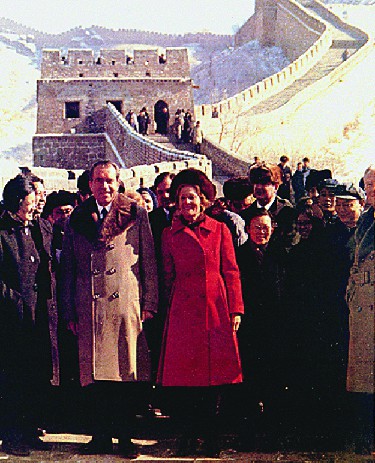10.7: 10.7 Approaches to Foreign Policy
- Page ID
- 147684
Frameworks and theories help make sense of the environment of governance in a complex area like foreign policy. A variety of schools of thought exist about how to approach foreign policy, each with different ideas about what “should” be done. These approaches also vary in terms of what they assume about human nature, how many other countries ought to be involved in U.S. foreign policy, and what the tenor of foreign policymaking ought to be. They help situate the current U.S. approach to many foreign policy challenges around the world.
Classic Approaches
A variety of traditional concepts of foreign policy remain helpful when considering the proper role of the United States in, and its approach to, foreign affairs. These include isolationism, the idealism versus realism debate, liberal internationalism, hard versus soft power, and the grand strategy of U.S. foreign policy.
- From circa 1789 to 1914, isolationism—whereby a country stays out of foreign entanglements and keeps to itself—was a popular stance in U.S. foreign policy. Among the founders, Thomas Jefferson thought that by keeping to itself, the United States stood a better chance of becoming a truly free nation. (Ironically, Jefferson later served as ambassador to France and president of the United States, both roles that required at least some attention to foreign policy.) Between the end of World War I and entry into World War II (1941), isolationist sentiment returned, based on the idea that Europe should learn to govern its own affairs. Then, after World War II, the United States emerged as a superpower and the military leader of Europe and the Pacific. Isolationism has never completely gone away, but operates in the background.
- Today, neo-isolationism means distancing the United States from the United Nations and other international organizations that get in the way. The strategy of selective engagement—retaining a strong military presence and remaining engaged across the world through alliances and formal installations—is used to protect the national security interests of the United States. However, this strategy also seeks to avoid being the world’s policeman.
- Liberal internationalism advocates a foreign policy approach in which the United States becomes proactively engaged in world affairs. Its adherents assume that liberal democracies must take the lead in creating a peaceful world by cooperating as a community of nations and creating effective world structures such as the United Nations. To fully understand liberal internationalism, it is helpful to understand the idealist versus realist debate in international relations.
- Idealists assume the best in others and see it as possible for countries to run the world together, with open diplomacy, freedom of the seas, free trade, and no militaries. Everyone will take care of each other. A classic example of a liberal internationalist is President Woodrow Wilson, who sought a League of Nations to voluntarily save the world after World War I.
- Realists assume that others will act in their own self-interest and hence cannot necessarily be trusted. They want a healthy military and contracts between countries in case others want to wiggle out of their commitments. Realism has a place in liberal internationalism because the United States approaches foreign relationships with open eyes and an emphasis on self-preservation.
- Soft versus hard power--Soft power, or diplomacy, is in line with liberal internationalism and idealism. By contrast, hard power allows the potential for military force, and is in the realm of realism. For example, the United States was rather isolationist in its approach to China, assuming it was a developing country that could safely be ignored. Then, President Nixon opened up China as an area for U.S. investment, and an era of open diplomatic relations (soft power) began in the early 1970s. As China modernized and began to dominate the trade relationship with the United States, many people applied the realist lens to consider whether China’s behavior really warranted its beneficial most-favored-nation trading status.
- Today, neoconservatives believe that rather than exercising restraint and always using international organizations as the path to international outcomes, the United States should aggressively use its might to promote its values and ideals around the world. These individuals advocate hard power.

- Grand strategy employs all available diplomatic, economic, and military resources to advance the national interest. Hard power may be utilized because it relies on developing clear strategic directions for U.S. foreign policy and the methods to achieve those goals, often with military capability attached. After World War II, the United States built military bases in Italy, Germany, Spain, England, Belgium, Japan, Guam, and Korea. It still operates nearly all these, though often under a multinational arrangement such as NATO. These bases help preserve stability on the one hand, and U.S. influence on the other.
link to learning
Several interest groups debate what should happen in U.S. foreign policy, many of which are included in this list compiled by project Vote Smart.
Summary
Classic theories of foreign policy divide into the isolationist camp and the internationalist camp. In the end, the complexity of international relationships, combined with a multifaceted decision-making process and a multiplicity of actors, leads to a U.S. foreign policy approach that uses a bit of all the schools of thought. The United States is being neoconservative when drone strikes are carried out unilaterally within the boundaries of another sovereign nation. It is being internationalist when building a coalition on the Iran nuclear deal or when participating in NATO initiatives.
- American Government 2e. Authored by: OpenStax. Located at: https://cnx.org/contents/nY32AU8S@5.1:xJJkKaSK@5/Preface. License: CC BY: Attribution. License Terms: Download for free at http://cnx.org/contents/9d8df601-4f1...50bf739e5f@5.1

